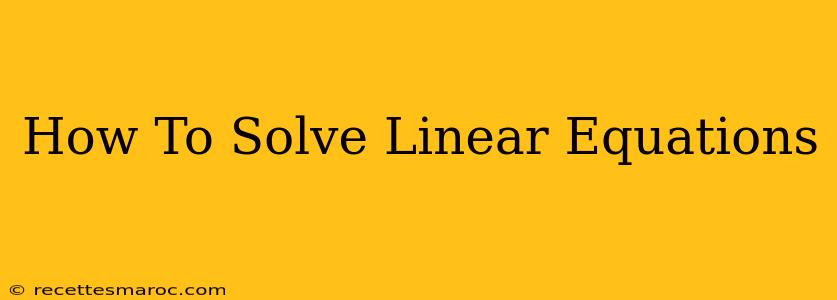Linear equations are the backbone of algebra, showing up in countless applications from physics and engineering to economics and finance. Understanding how to solve them is a fundamental skill. This guide provides a clear, step-by-step approach to mastering linear equations, regardless of your current skill level.
What is a Linear Equation?
Before diving into solutions, let's define our subject. A linear equation is an algebraic equation where each term is either a constant or the product of a constant and a single variable (to the first power). They are always characterized by a straight line when graphed. Simple examples include:
- 2x + 3 = 7
- y - 5 = 10
- 3x + 2y = 12
The goal in solving a linear equation is to isolate the variable (usually 'x' or 'y') on one side of the equation to find its value.
Solving One-Variable Linear Equations
Let's tackle the most basic type: one-variable linear equations. Here's a systematic approach:
1. Simplify Both Sides
First, simplify both sides of the equation independently. This involves combining like terms (terms with the same variable raised to the same power). For example:
Example: 3x + 5 - x = 11
Simplify: 2x + 5 = 11
2. Isolate the Variable Term
Next, isolate the term containing the variable by performing the inverse operation. If a number is added to the variable term, subtract it from both sides. If a number is subtracted, add it.
Example (continued): 2x + 5 = 11
Subtract 5 from both sides: 2x = 6
3. Solve for the Variable
Finally, solve for the variable by performing the inverse operation again. If the variable is multiplied by a number, divide both sides by that number. If the variable is divided by a number, multiply both sides by that number.
Example (continued): 2x = 6
Divide both sides by 2: x = 3
Therefore, the solution to the equation 3x + 5 - x = 11 is x = 3.
Solving Two-Variable Linear Equations
Two-variable linear equations require a slightly different approach. You typically need either a second equation (forming a system of equations) or to express one variable in terms of the other.
Solving Systems of Equations
Solving a system of two linear equations usually involves either substitution or elimination.
- Substitution: Solve one equation for one variable and substitute that expression into the other equation.
- Elimination: Multiply the equations by constants to make the coefficients of one variable opposites and then add the equations to eliminate that variable.
Example (Elimination):
- 2x + y = 7
- x - y = 2
Adding the two equations directly eliminates 'y': 3x = 9, which gives x = 3. Substituting x = 3 back into either of the original equations solves for y.
Expressing One Variable in Terms of the Other
If you only have one equation with two variables, you can solve for one variable in terms of the other. This results in an expression, not a single numerical answer.
Example: 2x + y = 10
Solving for y gives: y = 10 - 2x
Practice Makes Perfect!
The key to mastering linear equations is practice. Work through numerous examples, varying the complexity and types of equations. Online resources and textbooks offer plentiful practice problems. Don't be afraid to seek help when needed – understanding the underlying concepts is crucial for success in algebra and beyond. Remember to always check your answers by substituting them back into the original equation to verify the solution.

